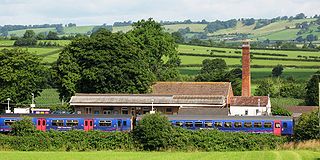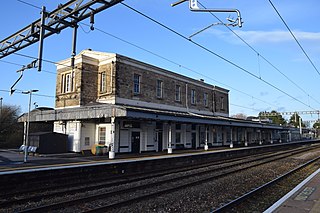Career
From 1835, he took on a number of contracts for building parts of the Great Western Railway (GWR). By 1838, he was resident in Reading, Berkshire, and continued to do contract work for the GWR.
In 1841, he moved to Chippenham, Wiltshire, where he bought Orwell House on New Road, and took over a blacksmith's business. Soon after, he began production of railway fittings and developed an ironworks on land north of Chippenham station. The business expanded in the 1850s and 1860s, with more land purchased to the north and east. Contract work for the GWR continued until 1861 when there was a dispute with that company; from 1861 to 1869 Brotherhood built components for railways and bridges across the British Empire, together with wagons and a small number of locomotives.
Activity at the Chippenham Works declined in the mid-1860s, and in 1869 it closed with extensive financial losses incurred by Brotherhood. The Works remained empty until the 1890s when the site was bought by Saxby and Farmer, railway signalling manufacturers, later becoming the Westinghouse Brake and Signal Company.
Brotherhood left Chippenham in 1868 and was appointed general manager of the Bute Ironworks in Cardiff. In 1874 he moved to Bristol and in 1875 he took a contract to build a goods shed for the GWR. From 1877 to 1879 Brotherhood assisted his son, also called Rowland, in sinking shafts for the Severn Tunnel.
Rowland Brotherhood (senior) died at his home in Bristol on 4 March 1883, and is buried there in Arnos Vale Cemetery.

The Great Western Railway (GWR) was a British railway company that linked London with the southwest, west and West Midlands of England and most of Wales. It was founded in 1833, received its enabling act of Parliament on 31 August 1835 and ran its first trains in 1838 with the initial route completed between London and Bristol in 1841. It was engineered by Isambard Kingdom Brunel, who chose a broad gauge of 7 ft —later slightly widened to 7 ft 1⁄4 in —but, from 1854, a series of amalgamations saw it also operate 4 ft 8+1⁄2 in standard-gauge trains; the last broad-gauge services were operated in 1892.

Chippenham is a market town in north-west Wiltshire, England. It lies 13 miles (21 km) north-east of Bath, 86 miles (138 km) west of London and is near the Cotswolds Area of Outstanding Natural Beauty. The town was established on a crossing of the River Avon, where some form of settlement is believed to have existed since before Roman times. It was a royal vill and probably a royal hunting lodge, under Alfred the Great. The town continued to grow when the Great Western Railway arrived in 1841. It had a population of 36,548 in 2021.

Castle Cary railway station is on the Reading to Taunton line 115.25 miles (185.48 km) south west of London Paddington and the Bristol to Weymouth line 47.75 miles (77 km) south of Bristol Temple Meads. The two routes share tracks between Westbury and Castle Cary stations and are both operated by Great Western Railway, which also manages the station. The station is 1 mile (1.6 km) north of the market town of Castle Cary and 5 miles (8 km) south of Shepton Mallet in a largely rural area of Somerset, England.

Swindon railway station is on the Great Western Main Line in South West England, serving the town of Swindon, Wiltshire. The station is 77 miles 23 chains down the line from the zero point at London Paddington and lies between Didcot Parkway and Chippenham. It is managed by Great Western Railway, which also operates all of the services from the station. It is the busiest station in Wiltshire, and the fifth busiest station in South West England.

Chippenham railway station is on the Great Western Main Line (GWML) in South West England, serving the town of Chippenham, Wiltshire. It is 93 miles 76 chains down the line from the zero point at London Paddington and is situated between Swindon and Bath Spa on the GWML. The Wessex Main Line diverges from the GWML to the southwest of Chippenham and runs to Trowbridge via Melksham.

The Avonside Engine Company was a locomotive manufacturer in Avon Street, St. Philip's, Bristol, England between 1864 and 1934. However the business originated with an earlier enterprise Henry Stothert and Company.
The Cheddar Valley line was a railway line in Somerset, England, running between Yatton and Witham. It was opened in parts: the first section connecting Shepton Mallet to Witham, later extended to Wells, was built by the East Somerset Railway from 1858. Later the Bristol and Exeter Railway built their branch line from Yatton to Wells, but the two lines were prevented for a time from joining up. Eventually the gap was closed, and the line became a simple through line, operated by the Great Western Railway.
The Wilts, Somerset and Weymouth Railway (WS&WR) was an early railway company in south-western England. It obtained Parliamentary powers in 1845 to build a railway from near Chippenham in Wiltshire, southward to Salisbury and Weymouth in Dorset. It opened the first part of the network but found it impossible to raise further money and sold its line to the Great Western Railway (GWR) in 1850.

George Hennet (1799–1857) was an English railway engineer and contractor. He undertook many contracts for Isambard Kingdom Brunel's broad gauge railways in the South West of England and funded the provision of extra facilities on the South Devon Railway, these formed the basis of a general trading business that he conducted.

The Westinghouse Brake & Signal Company Ltd was a British manufacturer of railroad signs. Founded by George Westinghouse, it was registered as "Westinghouse Brake Company" in 1881. The company reorganised in 1920, associating with Evans O'Donnell, and Saxby and Farmer which merged to form the "Westinghouse Brake & Saxby Signal Company". The 'Saxby' would be dropped from their title in 1935.

Sir Gabriel Goldney, 1st Baronet was a Conservative politician who sat in the House of Commons from 1865 to 1885. He was created a baronet in May 1880.

Wootton Bassett Junction railway station, formerly Wootton Bassett railway station, was a junction station in Wootton Bassett where the Great Western and South Wales Main Lines diverge. Opened in 1841, it closed in 1965.
The Chippenham and Calne line was a five mile long single-track branch railway line that ran along the valley of the River Marden in Wiltshire, England, from Chippenham on the Great Western Main Line to Calne, via two intermediate halts. Built by the Calne Railway Company and opened in 1863, the line was sold in 1892 to the Great Western Railway company.
The Malmesbury branch was a six-and-a-half-mile-long single track branch railway line in Wiltshire, England; it ran from Dauntsey station on the Great Western Main Line to Malmesbury. Promoted locally, it opened with considerable assistance from the Great Western Railway in 1877, and used the standard gauge. There was one intermediate station, Somerford.

Holt Junction was a railway station which served the village of Holt, Wiltshire, England between 1861 and 1966. It stood on the Wessex Main Line at its junction with the western end of the Devizes branch.

The Goldney family were a wealthy English merchant trading family, most associated with Wiltshire and latterly Bristol. Later branches of the family became the Goldney baronets.
John Bradley & Co was a company established in 1800 by John Bradley at Stourbridge in the West Midlands area of England. The company developed into a large industrial concern with furnaces, ironworks and mines. Under James Foster, John Bradley's half brother, it was instrumental in bringing the first commercial steam locomotive into the Midlands area in 1829. The firm stayed under family control until the early years of the 20th century when first the mining (1913) and then the ironworks (1919) were sold off. Part of the business continued to trade under the name John Bradley & Co. (Stourbridge) Ltd until after the Second World War.

Peter Brotherhood (1838–1902) was an English engineer. He invented the Brotherhood engine used for torpedoes as well as many other engineering products.

Thomas Evans Blackwell was an English civil engineer.














